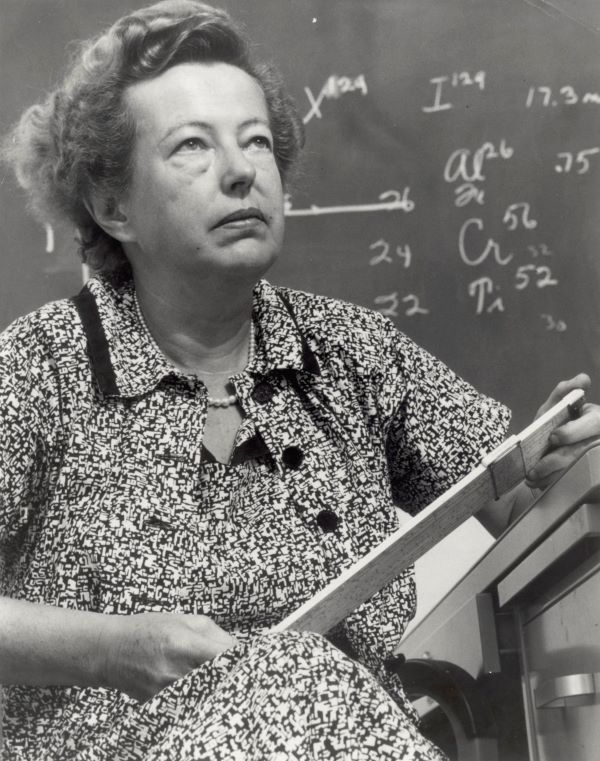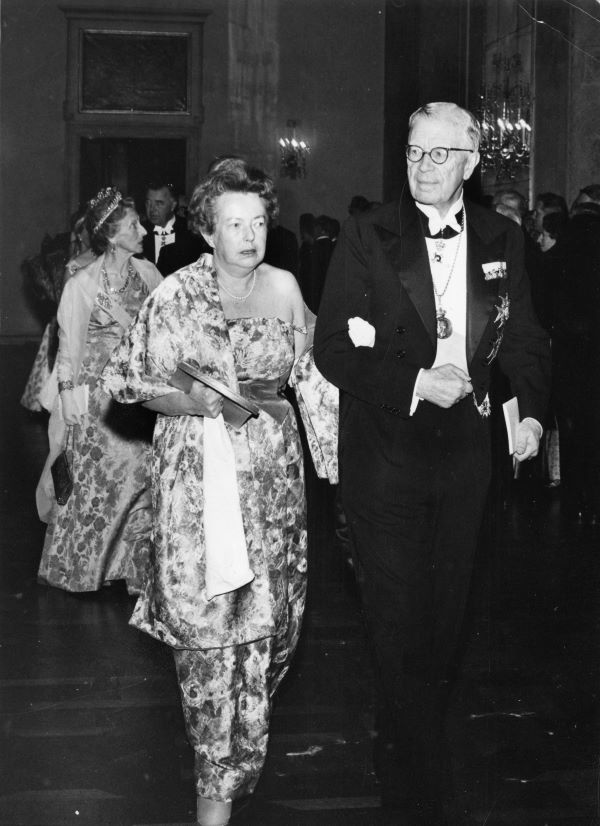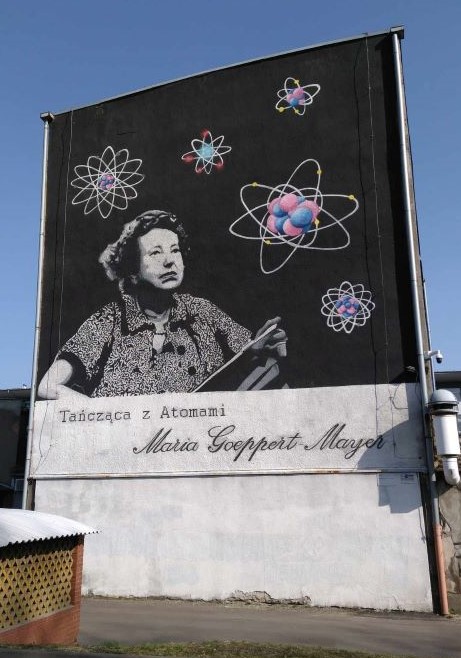Maria Goeppert-Mayer’s portrait | public domain, Wikimedia Commons
| Weronika Cygan |
She was awarded the Nobel Prize in Physics in 1963 for proposing the nuclear shell model of the atomic nucleus. That’s why she was given the nickname “Onion Madonna”.
Thanks to her origin from a family of intellectuals, she had an education that few women had access to at the time she lived. Despite this, her educational path was not easy..
“Other women researchers of those times also came from an environment where the education of girls was valued. Maria Goeppert-Mayer’s father was a sixth generation professor. Mother – a French teacher – also grew up in a family that valued education” says Elżbieta Stephan, PhD, DSc, Assoc. Prof. from the Faculty of Science and Technology of the University of Silesia in Katowice.
A rough start
The Nobel Prize winner, born on 28 June 1906 in Katowice, moved with her parents to Göttingen quite quickly. As a four-year-old, she soaked up the academic atmosphere – her father got a job at the local university. She finished school and then began studying mathematics. However, after three years she switched to quantum physics. Back then, the University of Göttingen enjoyed a unique reputation as a research centre in this rapidly expanding field. The supervisor of her doctoral thesis defended in 1930 was Max Born himself.
Shortly after graduating, Maria Goeppert-Mayer went to the United States, the homeland of her husband, chemist Joseph Edward Mayer.
“She left with the hope that she would have better chances for development and a scientific career there. Unfortunately, she was very disappointed, because the rules at American universities forbade the employment of spouses. The beginning of her career was a relay race of volunteers and various commissioned works. Nevertheless, she was constantly trying to stay in touch with the scientific community” explains Prof. Elżbieta Stephan.
A breakthrough in the career of the future Nobel laureate was her inclusion in the work on the project of American atomic weapons in the Manhattan programme. After the war, she was finally formally employed for the first time. Thanks to this, she was able to undertake research that eventually led her to the Nobel Prize in Physics.
Maria Goeppert-Mayer during the Nobel Prize ceremony (with King Gustaf Adolf) | public domain, Wikimedia Commons
Magic numbers
“For discoveries related to the shell model of atomic nuclei” – this was the justification of the Nobel Committee, awarding Maria Goeppert-Mayer and J. Hans D. Jensen a medal for their parallel work on the same issue.
“In order to understand the importance of the discovery, one has to realise what stage of development nuclear physics was at the times when Maria Goeppert-Mayer started her research” says the physicist from the University of Silesia. At that time, the composition of the atomic nucleus composed of nucleons (protons and neutrons) was already known, and the nature of the nuclear force was quite well versed. Many nuclei and their properties such as mass, charge and binding energy were known. However, there was still not enough knowledge on how the nucleus of an atom is constructed. Several puzzle pieces were missing or didn’t fit together in the previous concepts. Maria managed to find the necessary pieces of the puzzle.
The secret was in hidden in shells and magic numbers – the properties of strongly bound atomic nuclei with a certain number of protons or neutrons. For a long time, the regularity of these numbers remained misunderstood. Only the shell model described by the Nobel Prize winner explained the meaning of magic numbers and allowed us to understand how they translate into the properties of nuclei.
It is worth noting that the shells described by Maria Goeppert-Mayer should not be confused with the electron shells around the nucleus. The latter are much larger in size and their filling with electrons determines the chemical properties of atoms. Nuclear shells make up the nucleus itself – if the size of an atom were compared to a football stadium, the nucleus would be about the size of an onion. In both cases, the ordering is derived from the Pauli exclusion principle, which prohibits two particles (electrons, protons, neutrons) from occupying the same state.
Onion atomic nucleus
While, as a matter of simplification, the structure of the atom is sometimes compared to the Solar System – with the central Sun (atomic nucleus) and the surrounding planets (electrons) – in the case of the shell model of the atomic nucleus itself, this comparison would be too far-reaching. The nucleus does not have its “Sun” in the centre, because it is made up of equal protons and neutrons.
“In order to explain it, Maria Goeppert-Mayer introduced a comparison to an onion. You probably associate such an analogy with the movie “Shrek”, where it is said that ogres are like onions, because they are made of layers. It can also be applied to the atomic nucleus, which is made of shells filled separately by protons and neutrons. The quantum-mechanical description of this model required knowledge of both mathematics and quantum physics, so the preparation of the Nobel Prize winner during her studies and her skills in this field were of key importance” explains Prof. Elżbieta Stephan.
In addition, in the course of her work, the Nobel Prize winner noticed that the values of magic numbers predicted by the shell model did not agree with the data obtained as a result of experiments. This second major discovery ultimately led her to understand the structure of the atomic nucleus.
In her model of the atomic nucleus, Maria Goeppert-Mayer additionally introduced the concept of coupling of the nucleon’s spin with its orbital motion on a given shell. “This allowed the magic numbers to be recreated and ultimately contributed to the success of the shell model. It was an absolute breakthrough. From that moment on, nuclear physics knew what it was and how the object it dealt with worked. It was possible to predict the properties of nuclei based on the number of nucleons of a certain type” sums up the expert from the University of Silesia.
A mural of Maria Goeppert-Mayer on the wall of the Rectorate of the University of Silesia | photo: Weronika Cygan
A living legacy
The shell model of the nucleus proposed by the scientist from Katowice is still valid in physics and is constantly developed by successive generations of scientists. Another milestone in this history was the Nobel Prize awarded in 1975, this time for supplementing Maria Goeppert-Mayer’s concept with a new quality. Three physicists received the award: Aage Niels Bohr, Benjamin Mottelson and James Rainwater. They took into account the existence of deformed nuclei and drew attention to the so-called collective motions, when certain nucleons become activated, causing the surface of the nucleus to vibrate. The collective model complemented the shell model by better description of the properties of large nuclei far from the “magic numbers”.
The concept developed over 70 years ago (proposed in the journal Physical Review 78 from 1950) by the researcher born in Katowice still allows for the creation of new physical theories. New magic numbers and heavy atomic nuclei are constantly being sought.
“Physicists expect that there is still some island of stability and around the next magic number some nuclei are grouped, which will live not only for microseconds, seconds or minutes, but for years. The discovery of such nuclei would be a beautiful culmination of the shell model” says Prof. Elżbieta Stephan.
Maria Goeppert-Mayer was also active outside of her studies, actively participating in the social sphere. She has strongly expressed her opposition to nuclear proliferation. She died less than ten years after receiving the Nobel medal as a result of a heart attack.
In 2023, it will be 60 years since the Nobel Prize was awarded to the physicist.
Sources
- Laureaci Nagrody Nobla urodzeni na Śląsku. Wszechnica Górnośląskiego Towarzystwa Przyjaciół Nauk im. W. Roździeńskiego w Katowicach, 2000
- Hanel S., Maria Goeppert-Mayer – the ‘magic numbers’ champion [access: 27.06.2023]








